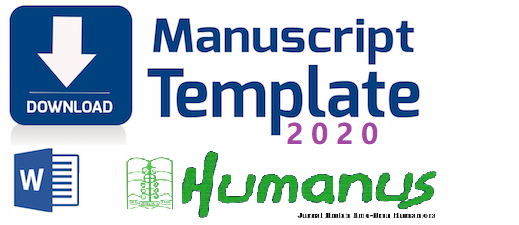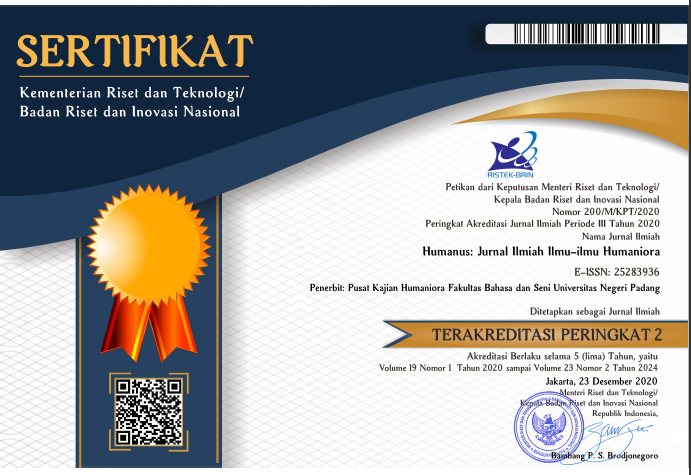Semantic Relation of Place Toponymy: Reflection of Minangkabau Migration in the West Coast of Sumatra
 ), Martin Kustati(2), Nelmawarni Nelmawarni(3), Zulfadli Aziz(4), Reflinaldi Reflinaldi(5),
), Martin Kustati(2), Nelmawarni Nelmawarni(3), Zulfadli Aziz(4), Reflinaldi Reflinaldi(5), (1) Universitas Islam Negeri Imam Bonjol
(2) Universitas Islam Negeri Imam Bonjol
(3) Universitas Islam Negeri Imam Bonjol
(4) Universitas Syiah Kuala
(5) Universitas Islam Negeri Imam Bonjol
 Corresponding Author
Corresponding Author
Copyright (c) 2022 Humanus
DOI : https://doi.org/10.24036/humanus.v21i1.112380
Full Text:
 Language : en
Language : en
Abstract
This study aims to describe types of meanings and identify the semantic relations of place names, as well as explains the migration in Minangkabau on the West Coast of Sumatra. A qualitative research was used where sources of data were taken from interview, Focus Group Discussion (FGD), and documents. The interview and FGD were conducted to society figures, community leaders and government officials. The documents include the names of 22 sub-districts in 11 districts from four provinces, written sources, and other relics related to the names. The findings show that the place names provide knowledge about the relations of the meaning and socio-cultural values. The relation among the meanings of the place names includes synonymy and antonym that reflects the migration of Minangkabau in West Coast of Sumatra. The results also indicated that toponymy studies are very important because the naming of places has not received attention among the communities and has not been a study of interest.
Keywords
References
Alasli, M. (2019). Toponyms’ contribution to identity: The case study of Rabat (Morocco). Proceedings of the ICA, 2, NA–NA.
Allwood, J. (2003). Meaning potentials and context: Some consequences for the analysis of variation in meaning. Cognitive Approaches to Lexical Semantics, 29–66.
Azaryahu, M. (2011). The critical turn and beyond: The case of commemorative street naming. ACME: An International e-Journal for Critical Geographies, 10(1), 28–33.
Biederman, I. (2017). On the semantics of a glance at a scene. In Perceptual organization (pp. 213–253). Routledge.
Burenhult, N., & Levinson, S. C. (2008). Language and landscape: A cross-linguistic perspective. Language Sciences, 30(2–3), 135–150.
Camalia, M. (2015). Toponimi Kabupaten Lamongan (Kajian Antropologi Linguistik). PAROLE: Journal of Linguistics and Education, 5(1), 74–83.
Chaer, A. (2009a). Sintaksis bahasa Indonesia: Pendekatan proses [Indonesian SYntaxis: Process Approach]. Rineka Cipta.
Chaer, A. (2009b). Sintaksis bahasa indonesia: Pendekatan proses [Indonesian SYntaxis: Process Approach]. Rineka Cipta.
Cooper, D. C., Gregory, I. N., Hardie, A., & Rayson, P. (2015). Spatializing and Analyzing Digital Texts: Corpora, GIS, and Places.
Crouch, S. E. (2009). Voice and verb morphology in Minangkabau, a language of West Sumatra, Indonesia [PhD Thesis]. External Organizations.
Cruse, A. (2011). Meaning in language: An introduction to semantics and pragmatics.
Evans, V. (2003). The structure of time: Language, meaning and temporal cognition. John Benjamins Publishing.
Gibbs Jr, R. W., & Colston, H. L. (2012). Interpreting figurative meaning. Cambridge University Press.
Gorys Keraf, D. (2009a). Diksi dan gaya bahasa [Diction and language style]. Gramedia Pustaka Utama.
Gorys Keraf, D. (2009b). Diksi dan gaya bahasa [Diction and language style]. Gramedia Pustaka Utama.
Gregory, I. N., & Hardie, A. (2011). Visual GISting: Bringing together corpus linguistics and Geographical Information Systems. Literary and Linguistic Computing, 26(3), 297–314.
Haugh, M. (2013). Speaker meaning and accountability in interaction. Journal of Pragmatics, 48(1), 41–56.
Helleland, B. (2012). Place names and identities. Oslo Studies in Language, 4(2).
Hirst, G. (2009). Ontology and the lexicon. In Handbook on ontologies (pp. 269–292). Springer.
Hjørland, B. (2007). Semantics and knowledge organization.
Hughes, J., Kroes, P., & Zwart, S. (2007). A semantics for means-end relations. Synthese, 158(2), 207–231.
Istiana, R. N. (2006). Analisis pemakaian disfemia pada rubrik gagasan surat kabar solopos. Thesis. Retrieved from https://digilib.uns.ac.id/dokumen/detail/3425/Analisis-pemakaian-disfemia-pada-rubrik-gagasan-surat-kabar-solopos.
Jackendoff, R. (2006). On conceptual semantics. Walter de Gruyter.
Jackson, H. (2014). Words and their Meaning. Routledge.
Jones, S., Murphy, M. L., Paradis, C., & Willners, C. (2012). Antonyms in English: Construals, constructions and canonicity. Cambridge University Press.
Jordan, P. (2020). Role of Place Names in Relating People and Space. Handbook of the Changing World Language Map, 2037–2051.
Klein, D. E., & Murphy, G. L. (2001). The representation of polysemous words. Journal of Memory and Language, 45(2), 259–282.
Klein, D. E., & Murphy, G. L. (2002). Paper has been my ruin: Conceptual relations of polysemous senses. Journal of Memory and Language, 47(4), 548–570.
Klepousniotou, E. (2002). The processing of lexical ambiguity: Homonymy and polysemy in the mental lexicon. Brain and Language, 81(1–3), 205–223.
Klepousniotou, E., & Baum, S. R. (2007). Disambiguating the ambiguity advantage effect in word recognition: An advantage for polysemous but not homonymous words. Journal of Neurolinguistics, 20(1), 1–24.
Klepousniotou, E., Pike, G. B., Steinhauer, K., & Gracco, V. (2012). Not all ambiguous words are created equal: An EEG investigation of homonymy and polysemy. Brain and Language, 123(1), 11–21.
Kridalaksana, H. (2013). Kamus Linguistik (edisi keempat) [Linguistics Dictionary (fourth edition)]. Gramedia Pustaka Utama.
Leech, G., Cruickshank, B., & Ivanic, R. (2001). An AZ of English grammar and usage. Longman.
Leidner, J. L., & Lieberman, M. D. (2011). Detecting geographical references in the form of place names and associated spatial natural language. SIGSPATIAL Special, 3(2), 5–11.
Liu, Y., & O’Halloran, K. L. (2009). Intersemiotic texture: Analyzing cohesive devices between language and images. Social Semiotics, 19(4), 367–388.
Lubis, A. H. H. (1991). Jenggala bahasa Indonesia: Ambiguitas, pragmatik, problematik [Indonesian forest: Ambiquity, pragmatics, problematic]. Fakultas Pendidikan Bahasa dan Seni, IKIP Medan.
Miftah, Y. (2008). Fenomena Geografis di Balik Nama-nama Tempat (Toponim) di Wilayah Kota Bandung [Geographical Phenomena in the Place Names (Toponymy) in Bandung]. Bandung: Jurusan Pendidikan Geografi FPIPS UPI. Tidak Dipublikasikan [Unpublished Thesis].
Miles, M. B., Huberman, A. M., & Saldana, J. (2013). Qualitative data analysis. Sage.
Minang, P. S., Aziza, M., & Sitepu, Y. (n.d.). Klasifikasi dan Kolokasi Nama Jalan di Bogor (Kajian Toponimi dengan Pendekatan Korpus Linguistik) [Classification and Collocation of Street Names in Bogor (Toponymy with Linguistics Corpus Approach]. Retrieved from linguistik.fib.ui.ac.id.
Murphy, M. L. (2003). Semantic relations and the lexicon: Antonymy, synonymy and other paradigms. Cambridge University Press.
Nasional, D. P. (2008). Kamus besar bahasa [Language dictionary]. Jakarta: PT Gramedia Pustaka Utama.
Nasution, A. H. (2018). Pivot-based hybrid machine translation to support multilingual communication for closely related languages. World Transactionson Engineering and Technology Education, 16.
Nasution, A. H., Murakami, Y., & Ishida, T. (2018). Designing a collaborative process to create bilingual dictionaries of Indonesian ethnic languages. Proceedings of the Eleventh International Conference on Language Resources and Evaluation (LREC 2018).
Nasution, S. M. (2014). Lexical Semantic In Angkola Language. Lexical Semantic In Angkola Language.
Nida, E. A. (2001). Language and culture: Contexts in translating. Shanghai Foreign Language Education Press.
Nurhayati, N. (2018). Toponymy and Branding of Modern Residential Sites in Semarang. E3S Web of Conferences, 73, 08021.
Pateda, M., & Pulubuhu, Y. (2010). Bahasa Indonesia di perguruan tinggi. Gorontalo: Viladan.
Piliang, Y. A. (2012). Semiotika dan hipersemiotika: Kode, gaya & matinya makna. Matahari.
Pondaag, A. F. (2013). Analisis Semiotika Iklan A Mild Go Ahead Versi “Dorong Bangunan” Di Televisi. Jurnal Acta Diurna, 2(1).
Purba, Y. (2019). Toponimi Desa-Desa di Kabupaten Humbang Hasundutan: Kajian Antropolinguistik.
Puspitasari, Y. A. D. (2016). Sistem Penamaan Desa Di Kecamatan Sumbersari Kabupaten Jember.
Rose-Redwood, R., & Alderman, D. (2011). Critical interventions in political toponymy. ACME: An International E-Journal for Critical Geographies, 10(1), 1–6.
Rudnicka, E. K., Piasecki, M. T., Piotrowski, T., Grabowski, Lukasz, & Bond, F. (2017). Mapping wordnets from the perspective of inter-lingual equivalence. Cognitive Studies| Études Cognitives, 17.
Ruskhan, A. G. (2011). Keunikan Nama-Nama Geografi Indonesia: Dari Nama Generik ke Spesifik. Jurnal Pendidikan Dan Kebudayaan, 17(3), 363–371.
Russell, B. (2013). An inquiry into meaning and truth. Routledge.
Sartini, N. W. (2010). Tinjauan Teoritik tentang Semiotik. Surabaya: Universitas Airlangga (PDF)(Http://Journal. Unair. Ac. Id/DownloadfullpapersLepasan% 20Naskah% 201% 20 (1-10). Pdf, Diakses Pada 27 September 2015).
Sidik, Y. S., Suyitno, P. A. W. W., & Saddhono, K. (2019). Textual Aspect of Friday Sermon Book and Relevance to Javanese Language Learning Material.
Stevenson, L. L. (2001). The Victorian Homefront: American Thought and Culture, 1860-1880: with a New Preface. Cornell University Press.
Sudaryat, Y. (2009). Makna dalam wacana. Bandung: Yrama Widya.
Sujarwo, O. P. W. (2018). Makna Kanyouku Me (Mata) dalam Novel Koizora Karya Mika [PhD Thesis]. Universitas 17 Agustus 1945 Surabaya.
Sukandi, S. S. (2014). First Language Interferences on Minangkabau-Indonesian EFL Students’ Linguistic Repertoire in the Process of Advancing their Multilingual Awareness. Proceedings of ISELT FBS Universitas Negeri Padang, 2, 443–453.
Tarmini, W. (2009). Kata Tanya dalam Konstruksi Interogatif Bahasa Indonesia: Kajian Sintaktis dan Semantis. Sosiohumaniora, 11(1), 77.
Tent, J. (2015). Approaches to research in toponymy. Names, 63(2), 65–74.
Vuolteenaho, J., & Berg, L. D. (2017). Towards critical toponymies. In Critical toponymies (pp. 15–32). Routledge.
Whorf, B. L. (1956). Language, thought, and reality: Selected writings of….(Edited by John B. Carroll.).
Woodman, P. (2015). The toponymy of absence. Review of Historical Geography and Toponomastics, 10(19–20), 7–16.
Yulianty, T. (2008). Ambiguitas dalam Psikolinguistik [Ambiquity in Psycholinguistics. Abstrak.
 Article Metrics
Article Metrics
 Abstract Views : 627 times
Abstract Views : 627 times
 PDF Downloaded : 199 times
PDF Downloaded : 199 times
Refbacks
- There are currently no refbacks.
Copyright (c) 2022 Humanus

This work is licensed under a Creative Commons Attribution-NonCommercial 4.0 International License.










